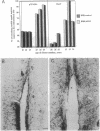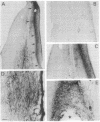Abstract
Six Rhesus monkeys between 24 and 29 years of age received unilateral transections of the fornix. Three monkeys then received intraventricular transplants of polymer-encapsulated baby hamster kidney (BHK) fibroblasts that had been genetically modified to secrete human nerve growth factor (hNGF). The remaining three monkeys received identical grafts except the cells were not modified to secrete hNGF. Monkeys receiving the fornix transection and control grafts displayed extensive reductions in the number of choline acetyltransferase- (57-75%) and p75 NGF receptor- (53%) immunoreactive medial septal neurons ipsilateral to the lesion/implant. In contrast, monkeys receiving transplants of encapsulated hNGF-secreting cells display only a modest loss of choline acetyltransferase- (0-36%) and p75 NGF receptor-(7-22.4%) immunoreactive septal neurons. Additionally, all monkeys receiving the hNGF-secreting implants, but none receiving control implants, displayed robust sprouting of cholinergic fibers within the septum ipsilateral to the transplant. Just prior to sacrifice, the capsules were retrieved and found to contain viable BHK cells releasing biologically relevant levels of hNGF. These data demonstrate that hNGF can provide trophic and tropic influences to aged primate basal forebrain neurons undergoing lesion-induced degeneration, supporting the contention that hNGF may prevent the degeneration of basal forebrain neurons in Alzheimer disease.
Full text
PDF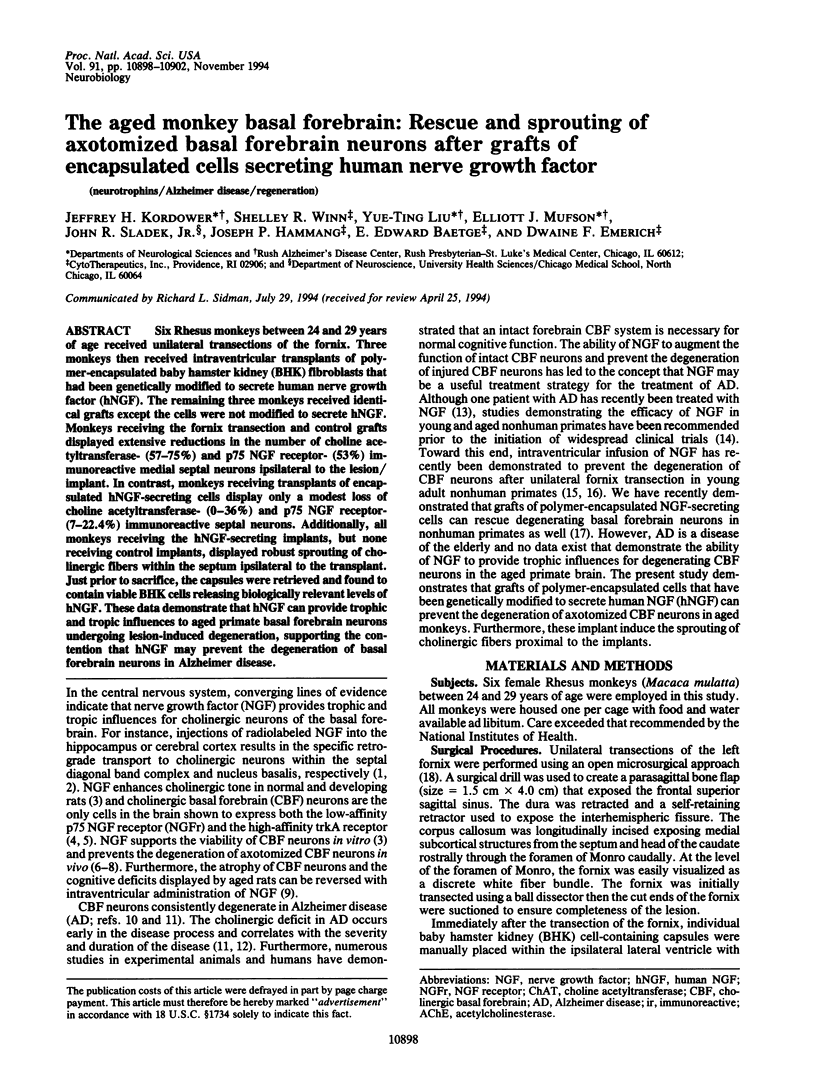
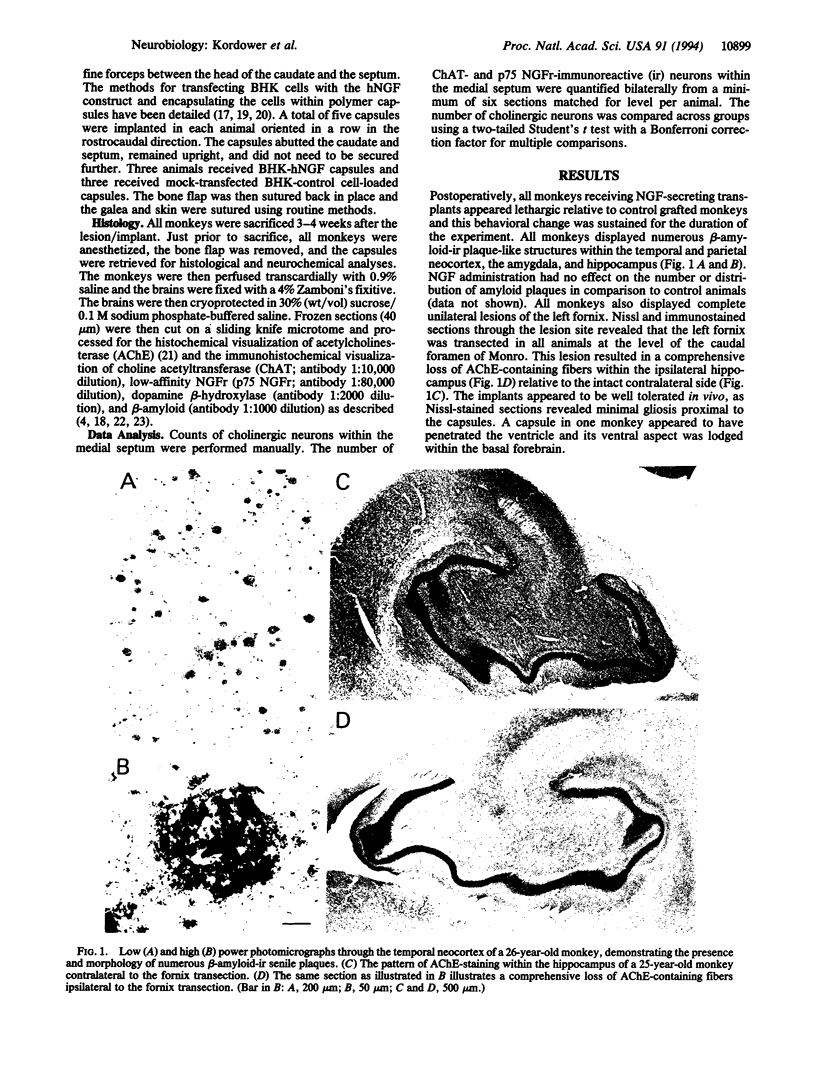
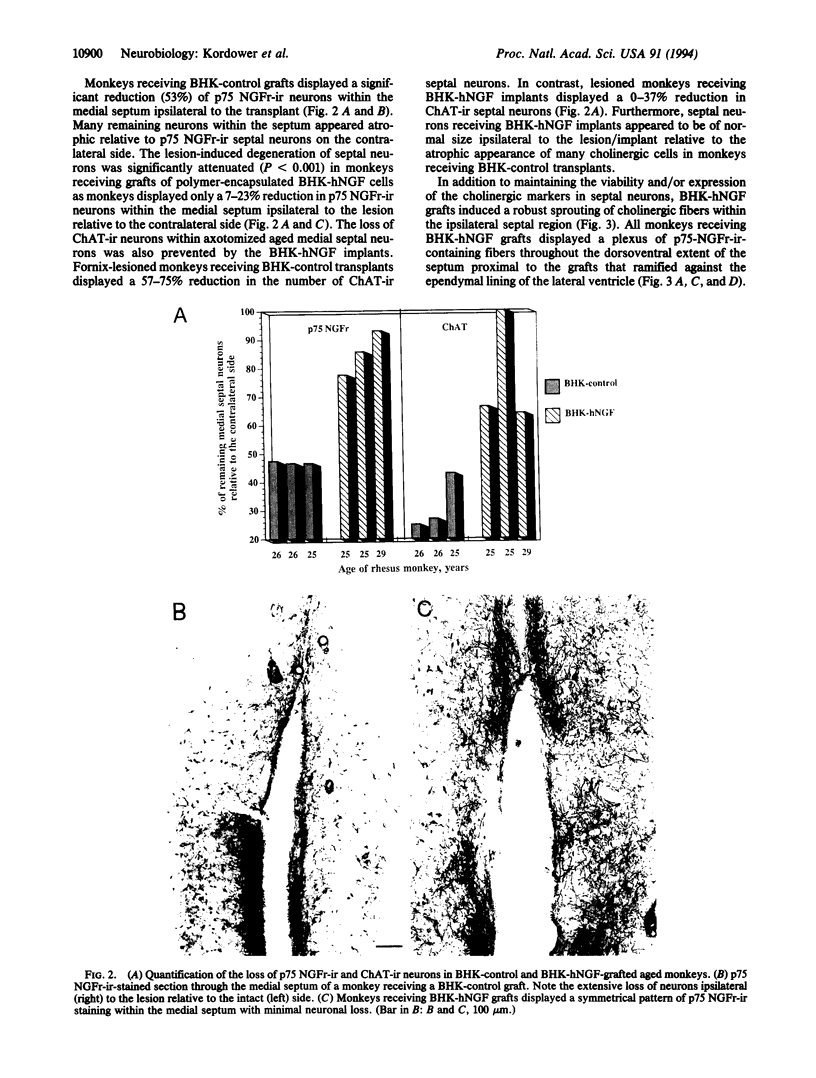
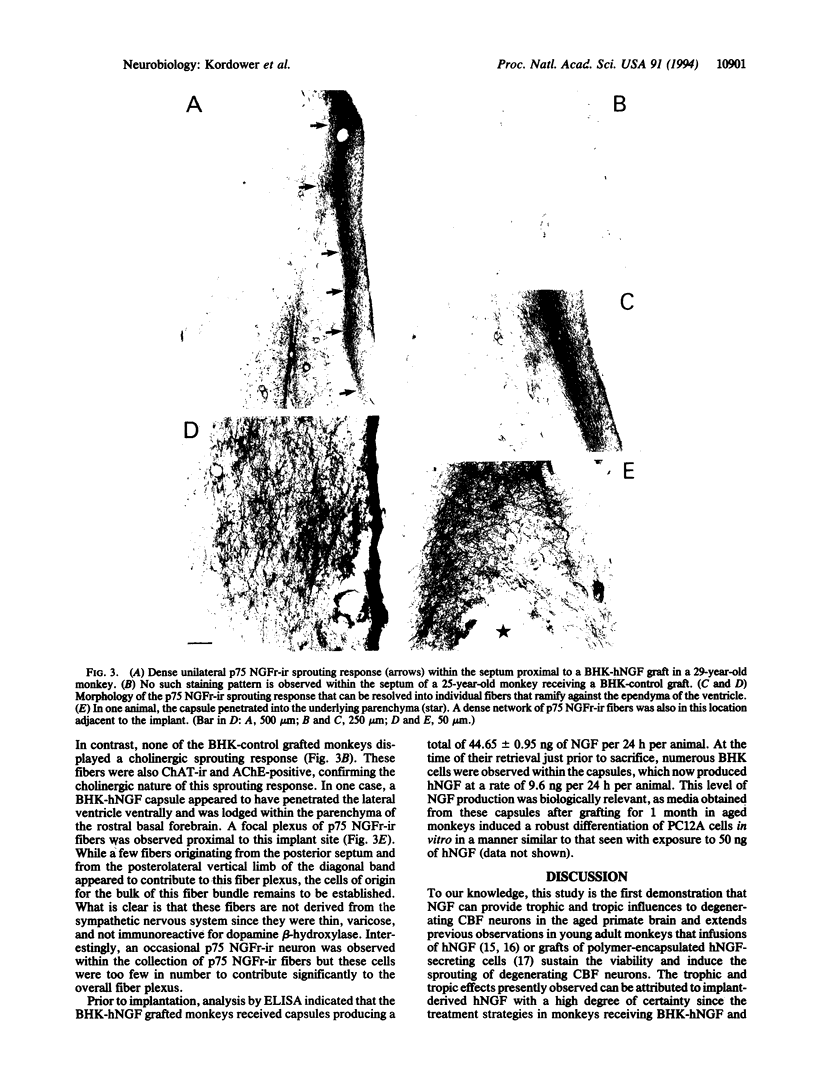
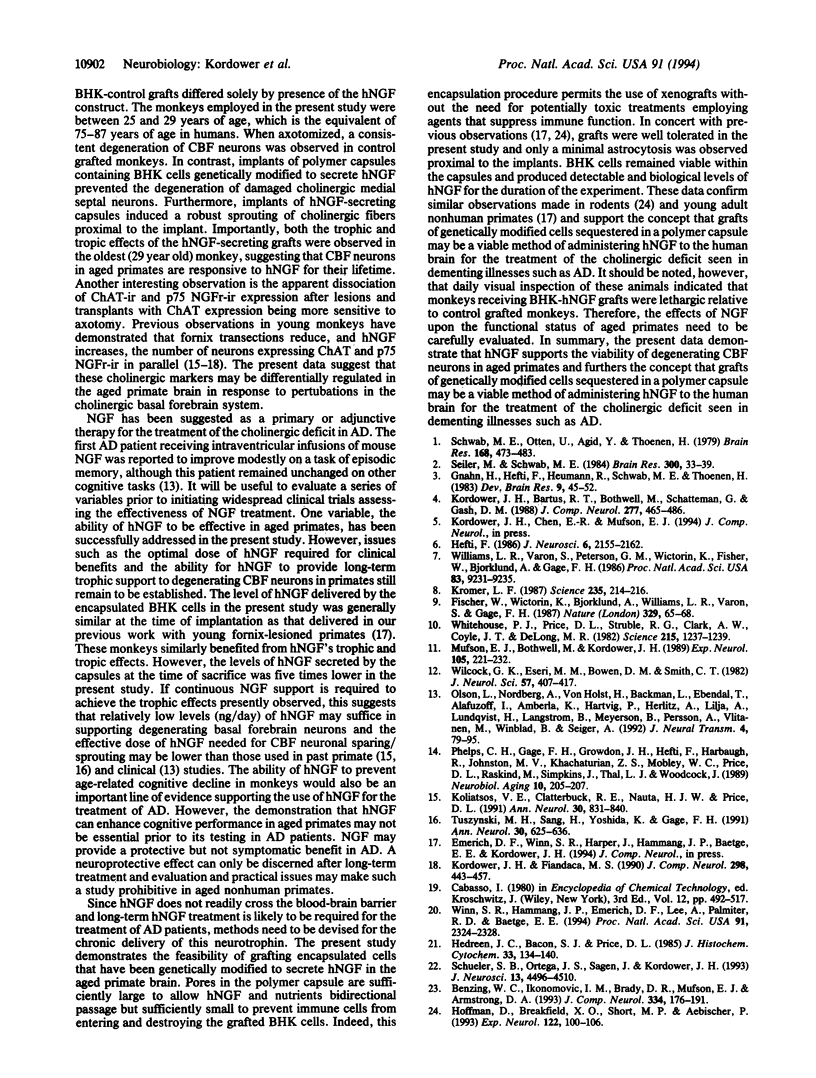
Images in this article
Selected References
These references are in PubMed. This may not be the complete list of references from this article.
- Benzing W. C., Ikonomovic M. D., Brady D. R., Mufson E. J., Armstrong D. M. Evidence that transmitter-containing dystrophic neurites precede paired helical filament and Alz-50 formation within senile plaques in the amygdala of nondemented elderly and patients with Alzheimer's disease. J Comp Neurol. 1993 Aug 8;334(2):176–191. doi: 10.1002/cne.903340203. [DOI] [PubMed] [Google Scholar]
- Fischer W., Wictorin K., Björklund A., Williams L. R., Varon S., Gage F. H. Amelioration of cholinergic neuron atrophy and spatial memory impairment in aged rats by nerve growth factor. Nature. 1987 Sep 3;329(6134):65–68. doi: 10.1038/329065a0. [DOI] [PubMed] [Google Scholar]
- Gnahn H., Hefti F., Heumann R., Schwab M. E., Thoenen H. NGF-mediated increase of choline acetyltransferase (ChAT) in the neonatal rat forebrain: evidence for a physiological role of NGF in the brain? Brain Res. 1983 Jul;285(1):45–52. doi: 10.1016/0165-3806(83)90107-4. [DOI] [PubMed] [Google Scholar]
- Hedreen J. C., Bacon S. J., Price D. L. A modified histochemical technique to visualize acetylcholinesterase-containing axons. J Histochem Cytochem. 1985 Feb;33(2):134–140. doi: 10.1177/33.2.2578498. [DOI] [PubMed] [Google Scholar]
- Hefti F. Nerve growth factor promotes survival of septal cholinergic neurons after fimbrial transections. J Neurosci. 1986 Aug;6(8):2155–2162. doi: 10.1523/JNEUROSCI.06-08-02155.1986. [DOI] [PMC free article] [PubMed] [Google Scholar]
- Hoffman D., Breakefield X. O., Short M. P., Aebischer P. Transplantation of a polymer-encapsulated cell line genetically engineered to release NGF. Exp Neurol. 1993 Jul;122(1):100–106. doi: 10.1006/exnr.1993.1111. [DOI] [PubMed] [Google Scholar]
- Koliatsos V. E., Clatterbuck R. E., Nauta H. J., Knüsel B., Burton L. E., Hefti F. F., Mobley W. C., Price D. L. Human nerve growth factor prevents degeneration of basal forebrain cholinergic neurons in primates. Ann Neurol. 1991 Dec;30(6):831–840. doi: 10.1002/ana.410300613. [DOI] [PubMed] [Google Scholar]
- Kordower J. H., Bartus R. T., Bothwell M., Schatteman G., Gash D. M. Nerve growth factor receptor immunoreactivity in the nonhuman primate (Cebus apella): distribution, morphology, and colocalization with cholinergic enzymes. J Comp Neurol. 1988 Nov 22;277(4):465–486. doi: 10.1002/cne.902770402. [DOI] [PubMed] [Google Scholar]
- Kordower J. H., Fiandaca M. S. Response of the monkey cholinergic septohippocampal system to fornix transection: a histochemical and cytochemical analysis. J Comp Neurol. 1990 Aug 22;298(4):443–457. doi: 10.1002/cne.902980406. [DOI] [PubMed] [Google Scholar]
- Kromer L. F. Nerve growth factor treatment after brain injury prevents neuronal death. Science. 1987 Jan 9;235(4785):214–216. doi: 10.1126/science.3798108. [DOI] [PubMed] [Google Scholar]
- Mufson E. J., Bothwell M., Kordower J. H. Loss of nerve growth factor receptor-containing neurons in Alzheimer's disease: a quantitative analysis across subregions of the basal forebrain. Exp Neurol. 1989 Sep;105(3):221–232. doi: 10.1016/0014-4886(89)90124-6. [DOI] [PubMed] [Google Scholar]
- Olson L., Nordberg A., von Holst H., Bäckman L., Ebendal T., Alafuzoff I., Amberla K., Hartvig P., Herlitz A., Lilja A. Nerve growth factor affects 11C-nicotine binding, blood flow, EEG, and verbal episodic memory in an Alzheimer patient (case report). J Neural Transm Park Dis Dement Sect. 1992;4(1):79–95. doi: 10.1007/BF02257624. [DOI] [PubMed] [Google Scholar]
- Phelps C. H., Gage F. H., Growdon J. H., Hefti F., Harbaugh R., Johnston M. V., Khachaturian Z. S., Mobley W. C., Price D. L., Raskind M. Potential use of nerve growth factor to treat Alzheimer's disease. Neurobiol Aging. 1989 Mar-Apr;10(2):205–207. doi: 10.1016/0197-4580(89)90032-8. [DOI] [PubMed] [Google Scholar]
- Schueler S. B., Ortega J. D., Sagen J., Kordower J. H. Robust survival of isolated bovine adrenal chromaffin cells following intrastriatal transplantation: a novel hypothesis of adrenal graft viability. J Neurosci. 1993 Oct;13(10):4496–4510. doi: 10.1523/JNEUROSCI.13-10-04496.1993. [DOI] [PMC free article] [PubMed] [Google Scholar]
- Schwab M. E., Otten U., Agid Y., Thoenen H. Nerve growth factor (NGF) in the rat CNS: absence of specific retrograde axonal transport and tyrosine hydroxylase induction in locus coeruleus and substantia nigra. Brain Res. 1979 Jun 8;168(3):473–483. doi: 10.1016/0006-8993(79)90303-2. [DOI] [PubMed] [Google Scholar]
- Seiler M., Schwab M. E. Specific retrograde transport of nerve growth factor (NGF) from neocortex to nucleus basalis in the rat. Brain Res. 1984 May 21;300(1):33–39. doi: 10.1016/0006-8993(84)91338-6. [DOI] [PubMed] [Google Scholar]
- Tuszynski M. H., Sang H., Yoshida K., Gage F. H. Recombinant human nerve growth factor infusions prevent cholinergic neuronal degeneration in the adult primate brain. Ann Neurol. 1991 Nov;30(5):625–636. doi: 10.1002/ana.410300502. [DOI] [PubMed] [Google Scholar]
- Whitehouse P. J., Price D. L., Struble R. G., Clark A. W., Coyle J. T., Delon M. R. Alzheimer's disease and senile dementia: loss of neurons in the basal forebrain. Science. 1982 Mar 5;215(4537):1237–1239. doi: 10.1126/science.7058341. [DOI] [PubMed] [Google Scholar]
- Wilcock G. K., Esiri M. M., Bowen D. M., Smith C. C. Alzheimer's disease. Correlation of cortical choline acetyltransferase activity with the severity of dementia and histological abnormalities. J Neurol Sci. 1982 Dec;57(2-3):407–417. doi: 10.1016/0022-510x(82)90045-4. [DOI] [PubMed] [Google Scholar]
- Williams L. R., Varon S., Peterson G. M., Wictorin K., Fischer W., Bjorklund A., Gage F. H. Continuous infusion of nerve growth factor prevents basal forebrain neuronal death after fimbria fornix transection. Proc Natl Acad Sci U S A. 1986 Dec;83(23):9231–9235. doi: 10.1073/pnas.83.23.9231. [DOI] [PMC free article] [PubMed] [Google Scholar]
- Winn S. R., Hammang J. P., Emerich D. F., Lee A., Palmiter R. D., Baetge E. E. Polymer-encapsulated cells genetically modified to secrete human nerve growth factor promote the survival of axotomized septal cholinergic neurons. Proc Natl Acad Sci U S A. 1994 Mar 15;91(6):2324–2328. doi: 10.1073/pnas.91.6.2324. [DOI] [PMC free article] [PubMed] [Google Scholar]




